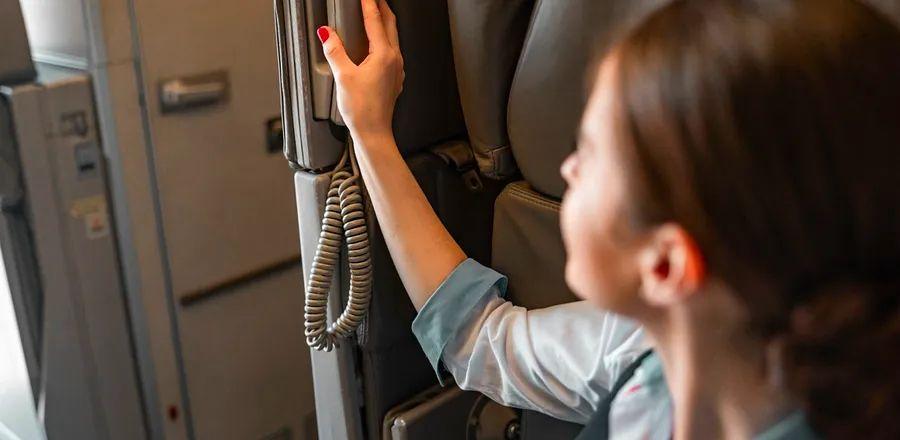5 Essential Safety Measures Flight Attendants Always Follow When They Are in the Air

It's easy to overlook the fact that flight attendants have responsibilities beyond serving drinks and snacks, finding room in the overhead bins, and distributing earbuds for in-flight entertainment. In reality, many of their most crucial tasks happen behind the scenes.
As many captains remind passengers prior to the aircraft's departure, the primary duty of a flight attendant is to ensure the safety of all passengers and crew before, during, and after the flight.
To achieve this, they must prioritize their own safety and security. For example, we’ve all heard pilots instruct flight attendants to take their jump seats during severe turbulence—this is to keep them safe. Additionally, they always remain seated and securely buckled during takeoff and landing, just like passengers. You might have heard that flight attendants sit on their hands while in their jump seats during these critical phases, but that’s not mandatory. The FAA only stipulates that flight attendants keep their hands "positioned in their laps or gripping the sides of their seats."
Here are five actions flight attendants take to ensure their safety and the safety of everyone aboard the aircraft.
Cabin Inspections
You might have observed that flight attendants make one last round through the cabin before takeoff and landing to ensure that tray tables are stowed and everyone has their seatbelts fastened. They perform similar checks throughout the flight, particularly when the captain activates the fasten-seatbelt sign.
In reality, flight attendants are continually monitoring the cabin, starting even before passengers board the aircraft. Prior to boarding, they verify that emergency equipment, such as the defibrillator and first aid kit, are onboard and functioning properly. They also test systems like emergency lighting and the public address system. The specifics of what gets tested and checked depend on each airline’s FAA-approved flight manual, but rest assured that flight attendants are diligent in ensuring everything is in optimal condition before the flight.
Communicating with the Pilots
You may not witness it firsthand while flying, but there’s ongoing communication between flight attendants and pilots. If you've noticed a flight attendant speaking on what appears to be a landline phone, they're actually in touch with one of the pilots in the cockpit through the plane’s intercom system. Cockpit doors remain locked during flights and are only opened when necessary, such as during pilot shift changes or meal breaks. Therefore, if pilots and flight crew need to discuss flight status or any deviations from the planned route, the intercom serves as their means of communication.
Pilots and flight attendants don't just communicate during the flight; they also convene before passengers board to discuss safety and service protocols.
Assessing Passengers
Even if it may not seem obvious, flight attendants are consistently focused on ensuring everyone's safety, even while passengers are boarding. A flight attendant may mentally note various details about passengers, from their age to the type of footwear they are wearing, in case this information becomes pertinent during any emergencies.
“I always pay attention to the type of shoes a passenger is wearing to assess their ability to move quickly and easily,” said flight attendant Amy Caris in a recent interview with Reader’s Digest. “If I spot someone in high heels during boarding, I make a mental note to include a command about removing them if necessary.”
Flight attendants are also on the lookout for able-bodied passengers, or ABPs, who could assist in case of an emergency. They take note of where these individuals are seated for future reference if assistance is needed.

Feruzbek/Shutterstock
Preflight safety and exit row instructions
Anyone who has attended an in-flight briefing knows that flight attendants are required to ensure all passengers are informed about safety measures before every flight. As mandated by the FAA, the briefing covers 10 essential points, including the ban on smoking, guidance on when to fasten seatbelts, and the locations of emergency exits.
Today, the preflight briefing is frequently recorded in a studio with much fanfare and played on the seatback screens prior to takeoff.
While seasoned travelers may have heard these briefings numerous times and may tune them out at some point, flight attendants are thoroughly trained to master all the details of these safety protocols so they can effectively assist passengers during an emergency.
It is the responsibility of flight attendants to inform passengers sitting in the exit rows about their duties. Passengers must acknowledge this responsibility when purchasing their tickets online. The rules regarding exit row seating state that passengers must be over 15, capable of understanding instructions, physically able to help, and not engaged in other tasks. Due to these safety considerations, certain passengers may be prohibited from sitting in exit row seats.
The FAA also suggests an in-person briefing where flight attendants confirm with exit row passengers whether they are willing to assist in an emergency; verbal consent from each passenger is required. This can occur anytime after all passengers are seated but must be completed before flight attendants are instructed to take their seats for takeoff.
Performing a silent review
Ultimately, when flight attendants are seated in their jump seats before takeoff, they frequently engage in a silent review, or a 30-second recap. This involves mentally going over the safety procedures they would need to implement during an emergency.
When seated in their jump seats, flight attendants may take on a partial brace position, which is a more relaxed form of the posture that everyone aboard should adopt during an emergency. This can involve either sitting on their hands or gripping their jump seats during takeoff or landing. However, passengers need not mimic this position. It allows flight attendants to respond swiftly and effectively to assist everyone else in case of an emergency.

1

2

3

4

5
Evaluation :
5/5